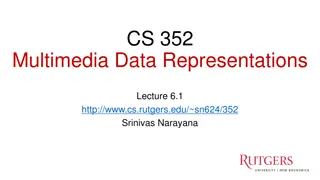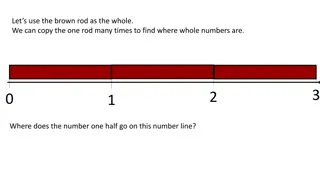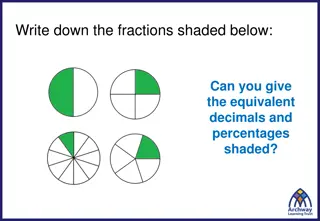Understanding Data Types and Representations in Mathematics
This content covers topics such as converting numbers, working out angles, simplifying expressions, and categorizing data types as discrete or continuous. It also includes examples related to the weight of a dog, number of students, and other real-world scenarios. Additionally, it explores the hours of sunshine in the UK each month and the visualization of this data using a line graph.
Download Presentation

Please find below an Image/Link to download the presentation.
The content on the website is provided AS IS for your information and personal use only. It may not be sold, licensed, or shared on other websites without obtaining consent from the author. Download presentation by click this link. If you encounter any issues during the download, it is possible that the publisher has removed the file from their server.
E N D
Presentation Transcript
From Spring 1 ? Convert 16?2 to ??2 ? ? From last term: Work out angle ? and give reasons. From last year: Simplify 20?+10 10?+5
Mark your work 16 ?2= 400 400 = 160000 ??2 16 ?? 4 ? 400 ?? 1002 4 ? 400 ?? ????? ??? = ????? ??? ?? ???????? ??? ?? ????????? ?????? ?? ? ???????? ??? ?? 180 ?? ????? ??? = 50 ????? ? = 50 ?? ????????? ??????? ? ?????
Mark your work 20? + 10 10? + 5=10(2? + 1) 5(2? + 1)=10 5= 2 ?????????
The weight of a dog The number of students in a class The height of a person The result of rolling a dice Time taken to run 5K The temperature The number of apples in an orchard The pressure exerted by an elephant The circumference of a circle The amount of money in a savings account Shoe size The number of viewers of a TV show These cards represent two different types of data. In pairs put these cards into two groups.
The weight of a dog The number of students in a class The height of a person The result of rolling a dice Time taken to run 5K The temperature The number of apples in an orchard The pressure exerted by an elephant The circumference of a circle The amount of money in a savings account Shoe size The number of viewers of a TV show Discrete data can only take certain values. Continuous data can take any value (within a range). Which data is discrete? Which data is continuous?
The weight of a dog Continuous The number of students in a class Discrete The height of a person Continuous The result of rolling a dice Discrete Time taken to run 5K Continuous The temperature Continuous The number of apples in an orchard Discrete The pressure exerted by an elephant Continuous The circumference of a circle Continuous The amount of money in a savings account Discrete Shoe size Discrete The number of viewers of a TV show Discrete Discrete data can only take certain values. Continuous data can take any value (within a range).
The hours of sunshine each month in the UK is shown in the table: Jan Feb Mar Apr May Jun Jul Aug Sep Oct Nov Dec 19 24 37 55 59 62 68 70 59 48 35 26 ?? A line graph can be drawn to show how the number of hours sunshine changes as a year passes. ?? ?? ?? ????? ?? ?? ?? Jan Feb Mar Apr May Jun Jul Aug Sep Oct Nov Dec ????
The hours of sunshine each month in the UK is shown in the table: Jan Feb Mar Apr May Jun Jul Aug Sep Oct Nov Dec 19 24 37 55 59 62 68 70 59 48 35 26 ?? This line graph is an example of a time series graph. ?? ?? ?? It can be drawn for discrete or continuous data and shows how data changes over time. ????? ?? ?? ?? Jan Feb Mar Apr May Jun Jul Aug Sep Oct Nov Dec ????
Decide which of the following descriptions you would draw a time series graph for. The annual average temperature in the UK from 2008 to 2018. The number of sweets in 5000 bags produced by Haribo The quarterly sales profit for a clothes shop for the year 2018 The heights of children in particular school. The daily food consumption of a family over a week The birth rate in Scotland from 1900 to 2000.
Decide which of the following descriptions you would draw a time series graph for. The annual average temperature in the UK from 2008 to 2018. The number of sweets in 5000 bags produced by Haribo The quarterly sales profit for a clothes shop for the year 2018 The heights of children in particular school. The daily food consumption of a family over a week The birth rate in Scotland from 1900 to 2000.
Title: Time Series Graphs A time series graph can show trends in the data as well as each individual values of the data. In your books: Ben s quarterly gas bills over a period of two years are shown in the table Jan-Mar 65 68 Apr-Jun 38 42 Jul-Sep 24 30 Oct-Dec 60 68 2017 2018 Plot the data on a graph and comment on any pattern in the data.
Consolidation 1. 2.

















































